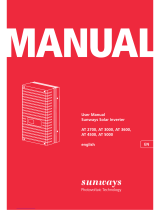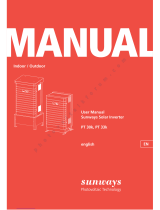Page is loading ...

MANUAL
User Manual for Sunways
Solar Inverters NT 2600, NT 4000 and
NT 6000

300 mm
510 mm
180 mm

EN
List of Contents
1.0 General information
1.1 Safety information
1.2 Sunways Solar Inverters
NT 2600, NT 4000 and NT 6000
2.0 Information on installation
2.1 Safety information
2.2 Installation
General safety information
Opening the unit
Scope of supply, inspecting the delivery
Integration into the PV system
Design of the PV generator
Standard components of a PV system
Protection concept
Electrical safety
Mechanical safety
Information on cleaning
Requirements on the place of installation
Electrical connection and cable entry
Grid connection
PV generator connection
Important Information
Communication connections
Connecting the sensors
83
84
85
86
87
88
90
91
93
94
95
97
98
100
102
79

2.3 Commissioning
3.0 Information on operation
3.1 Monitoring and diagnosis
3.2 Sunways NT Monitor software
3.3 Fault indications
3.4 Fault diagnosis
3.5 Warranty terms and conditions
Switching the solar inverter on and off
Configurations
Structure and menu levels for configuration
Display
Data memory
General information
Initialising the remote modem
Connection and circuitry options
Configuring the interface cables
Sunways NT Monitor data acquisition
Operation of Sunways NT Monitor
Screen displays
Indications, causes and remedies
Warranty period
Terms and exclusion of liability for
solar inverters
104
106
108
111
112
113
114
115
120
122
123
125
127
130
80

EN
4.0 Appendix
4.1 Subject and abbreviation index
4.2 Function and information index
Designation and description
Functional principle and explanations
Block diagram
Technical data
TYCO SOLARLOK connectors
Conformity and safety declarations
General exclusion of liability, rights,
registered trademarks
133
135
138
140
144
146
150
81

82
1.0 General information

General safety information
All safety hints contained in this section
and throughout the User Manual must
be complied with at all times to guarantee
the user's safety. The described product
must not be operated if any mechanical
or electrical components are defective.
Before commissioning the system, we
strongly advise you to carefully read and
heed the instructions! Non-compliance
can have serious consequences, for exam-
ple damage to the unit or other property
or physical injuries with possible loss of
life.
The solar inverter must be installed by a
trained, qualified electrician. The electrici-
an must be approved by the competent
electricity board (EB).
The relevant tasks to be carried out are
identified by an additional adjacent
symbol in the respective chapter headings.
83
EN
1.1 Safety information
The User Manual contains safety hints.
These are identified by a triangle with an
exclamation mark.
!

Opening the unit
Before opening the cabinet, the unit must
always be disconnected from the grid and
from the PV generator.
The unit continues to conduct a hazardous
voltage internally and at the connection
sockets for ca. five minutes after disconnec-
ting from the PV generator. The energy
storage capacitors are only fully discharged
after this period.
After disconnecting the unit from the grid
and from the PV generator, you must wait
at least five minutes before opening the
unit.
84
!

85
EN
1.2 Sunways Solar Inverters NT 2600,
NT 4000 and NT 6000
Scope of supply
· Sunways Solar Inverter in the NT series
· Installation frame
· Manual, setup, warranty card, CD-Rom
with software
· 2 pairs of TYCO SOLARLOK connectors
Inspecting the delivery
The condition of our products is checked
prior to delivery. Although our products
are carefully packed in recyclable packing,
transportation damages can still occur.
These are generally the transport compa-
ny's responsibility.
Please inspect the delivered solar inverter
thoroughly!
If you discover any damage to the packing
or the solar inverter, please inform the
transport company immediately. Your
specialist dealer will be glad to assist you
if required. Any damages must always be
reported to the transport company in wri-
ting seven days after receipt of the goods
at the latest.

Integration of the solar inverter into the
PV system
Design of the PV generator
The technical data of the selected PV
generator must be within the specifica-
tion of the solar inverter (see Technical
Data). The Sunways NT Sundim design
program for the PV generator may be
helpful. Sunways NT Sundim is available
on the enclosed CD or from our web-
site, www.sunways.de.
Please take account of the following
points before planning your system:
· Pay attention to the skyward alignment
of the modules. You will obtain maxi-
mum yield in Central Europe with a
module inclination of 30° to the hori-
zontal and a direct southerly alignment
of the generator field.
· The output of the cells decreases as the
module temperature increases. Install
your PV generator with adequate rear
ventilation.
· Check your PV generator for soiling ca.
every three years. This occurs particularly
at the lower edge of the modules and
forms a film, which even heavy rain can-
not wash away. Decreases in yield can be
prevented by cleaning with a wet cloth
or a brush.
· Avoid shading of individual modules or
solar cells in your system. This can result
in heavy losses in yield.
86

87
EN
Standard components of a PV system
Depending on the recommendations of
your electrician, your PV system will con-
sist of the following components:
PC
(3)
SUNWAYS
NT
PV
PV
(1)
(2)
(4)
(1) PV generator switch
(2) Irradiation sensor with
integrated temperature
sensor
(3) Mains fuse
(4) Energy meter
Grid
PV generator switch:
Designed as DC load break cut-out to cut
off the PV generator from the solar inverter.
Dimensioning: min. 800 V, ≥ 16 A
Grid connection:
3-phase (Feed-in: 1-phase; grid monitoring:
3-phase)
Standard components of the PV system

Protection concept The following parameters are monitored
continuously and in parallel by the micro-
controller and displayed on the screen:
· AFI error (ground fault)
· Overheating of the cooling element
· DC overvoltage
· AC undervoltage/overvoltage
In the event of a fault, the conversion is
immediately blocked and the grid relay
disconnected.
In addition, the following protective devi-
ces are provided on both grid and PV
generator side:
· Grid-side varistors
Protect the power semiconductors from
high-energy, time-limited voltage spikes on
the grid and provide for a reduction of
energy in the throttle in the event of grid
disconnection.
· Generator-side varistors
Thermally monitored varistors provide pro-
tection against atmospheric overvoltages
(e.g. due to remote strikes during storms).
88

89
2.0 Information on installation

Electrical safety
Before opening the cabinet, the solar
inverter must be disconnected from the
grid and from the PV generator.
The solar inverter continues to conduct
a hazardous voltage internally and at the
connection sockets for the PV generator
for ca. five minutes after disconnecting
from the PV generator. The energy storage
capacitors are only fully discharged after
this period.
After disconnecting the solar inverter from
the grid and PV generator, you must wait
at least five minutes before opening the
solar inverter.
Mechanical safety
During installation, make sure that the
cables or connection lines fitted to the
solar inverter are securely laid and that
suitable mechanical cable supports
(cable ducts etc.) are used.
2.1 Safety information
!
90

91
EN
Information on cleaning
Before cleaning, disconnect the system
from the power grid by opening the grid
breaker (main fuse) and open the DC
switch on the PV generator, in order to
exclude the danger of electric shocks.
Use a soft, dry cloth to clean the system.
Never use corrosive, solvent-containing
or abrasive cleaners or polishes.
!

2.2 Installation
The solar inverter must be installed by a trained, qualified electrician. A special tool is
necessary for installation. Please read this chapter very carefully.
92
➟
150 mm
Cool
Air
Warm
Air
300 mm
300 mm
150 mm
➟
➟
➟

93
EN
If installing the solar inverter in a switch
box, ensure adequate heat dissipation.
The ambient temperature must not fall
below or exceed –25°C or +40°C.
The solar inverter should not be exposed to
direct solar irradiation, so as to protect it
from unnecessary external heating.
· Protection from damp and foreign bodies
The IP54 high protection class permits instal-
lation both inside and in roofed outdoor
areas, but the solar inverter must not be
exposed to direct rain.
Make sure that the solar inverter cannot be
exposed to foreign bodies (deposits of dust
and dirt).
Requirements on the place of installation
· Mechanical bearing capacity
During installation please bear in mind
that the solar inverter weighs 26 kg. The
installation base must be firm and capable
of continuously bearing the weight.
· Thermal interaction
The installation base must consist of
flame-retardant material (e.g. no wood or
plastic in the base; concrete and brickwork
are suitable), as the heat sink emits tempe-
ratures up to max. 85°C.
A minimum distance of 300 mm must be
maintained above and below the cabinet,
and 150 mm on right and left from other
units, cabinets, ceilings, cable ducts etc..
The solar inverter must be installed verti-
cally, so as not to hinder adequate free
convection.
Several solar inverters must not be instal-
led on top of each other, so as to prevent
reciprocal heating.

Electrical connection and cable entry
For installation, please observe the
instructions in the "Setup" leaflet!
94
!
If the solar inverter is fixed to the installa-
tion frame, the electrical connection can
be led through. The unit may only be ope-
ned by a qualified electrician. The cabinet
cover must first be released and removed.
The following cable inlets are located on
the underside:
–DC +DC
RS 232, RS 485,
Irradiation sensor with inte-
grated temperature sensor
cable
AC wiring loom
L1, L2, L3, N, PE
–DC
+DC
Fig.: Inlets on the unit underside

95
EN
Grid connection
The grid connection of the solar inverter
must have 5 wires (L1, L2, L3, PE, N). Cable
cross-sections of 5 x 4 mm2 are recommen-
ded.
The solar inverter is connected to the
supply grid via the circuit board terminals
inside the unit.
!
As line safety element in the grid feed-in
direction, we recommend a 3 x 25 A auto-
matic cut-out. No consumption units must
be connected to the feed line from the
solar inverter to the automatic cut-out.
The solar inverter only feeds in via termi-
nal L1.
If several solar inverters are operated in
parallel, the feed-in phase L1 of the unit
must be evenly distributed over grid
phases L1, L2 and L3 (see figure below).
L1 N L2 L3 PE
L1 N L2 L3 PE L1 N L2 L3 PE
L1
L2
L3
N
PE
Three-phase grid connection distributed over three units

96
You must use adequately dimensioned
cable cross-sections in order to avoid a
considerable increase in the grid impedan-
ce between the domestic distribution and
the solar inverter. The terminal range of
the AC terminals is 0.5 to 6 mm2 for rigid
cables and 0.5 to 10 mm2 for flexible
cables. With a high grid impedance, i.e.
with a long line or too small a cross-
section, the voltage increases at the grid
terminal during feed-in.
If the terminal voltage exceeds the per-
missible value, the solar inverter is discon-
nected from the grid.
Carefully perform the following steps:
· Check that there is no voltage before
introducing the supply main into the
unit.
· Lead the 5-core AC cable (outer diame-
ter 9 – 17 mm) through the M25 threa-
ded cable gland.
· Connect cables L1, L2, L3, PE and N to
the relevant circuit board terminal with
the help of a slot-head screwdriver (see
figure below).
· Tighten the M25 screw connection, so
that the cable cannot exert any mechanical
force on the circuit board terminal.
/

